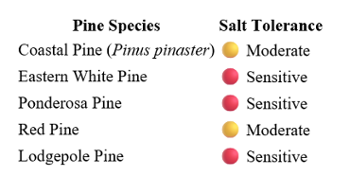The Hidden Cost of Recycled Water: How It Harms Pine Trees and What You Can Do
As the demand for sustainable water solutions rises, recycling wastewater has become a preferred method for irrigation in various contexts, including urban landscaping and agriculture. While the benefits of using recycled water are often emphasized, such as water conservation and nutrient supply, significant concerns cannot be overlooked, particularly regarding the specific needs of pine trees. Let’s explore the disadvantages of using recycled water for these coniferous giants.
Salinity Issues
One of the most pressing concerns regarding recycled water is its often-elevated salinity levels. Salt, a common byproduct of various treatment processes, can harm plants, particularly species like pine trees that are not salt-tolerant. High salinity can cause osmotic stress, making it more difficult for trees to absorb water and essential nutrients. Prolonged exposure to elevated salt levels can significantly impact the overall health and growth of pine trees, leading to symptoms such as yellowing needles, stunted growth, and, in severe cases, tree mortality. The chart below shows the severity of the sensitivity from elevated salinity levels:

Signs of Elevated Salt Levels:
1. Needle Browning or Tip Burn
Variability in Water Quality
The quality of recycled water can vary greatly depending on its source and the treatment processes it has undergone. This inconsistency can create challenges for irrigation management, especially for pine trees, which thrive in specific environmental conditions, including pH levels. If the recycled water has an unsuitable pH, whether too high or too low, it can interfere with the nutrient uptake essential for healthy tree growth. Therefore, careful monitoring of water quality is crucial.
Don’t Let Salt Steal Your Shade
So, using recycled water for irrigation may offer an innovative solution to the issue of water scarcity. However, it presents challenges, particularly for sensitive species like pine trees. Problems such as salinity and fluctuations in water quality can create significant drawbacks.
If you notice any of these signs in your pine trees, you may be facing elevated levels of salt in the water, which could be causing the premature decline of your beautiful pines. By reaching out to Root Tree Service, our PHC experts are here to help protect and preserve your pine trees with an effective and environmentally responsible solution to help reduce salinity levels and keep your pine trees healthy and vibrant.
Go Back Salinity Issues
One of the most pressing concerns regarding recycled water is its often-elevated salinity levels. Salt, a common byproduct of various treatment processes, can harm plants, particularly species like pine trees that are not salt-tolerant. High salinity can cause osmotic stress, making it more difficult for trees to absorb water and essential nutrients. Prolonged exposure to elevated salt levels can significantly impact the overall health and growth of pine trees, leading to symptoms such as yellowing needles, stunted growth, and, in severe cases, tree mortality. The chart below shows the severity of the sensitivity from elevated salinity levels:

Signs of Elevated Salt Levels:
1. Needle Browning or Tip Burn
- The tips of needles turn brown or yellow, especially on older foliage.
- Damage usually starts at the tip and moves inward.
- his is one of the earliest and most obvious signs.
- Premature shedding of needles.
- The tree may look sparse or thinning, especially on lower branches.
- New shoots or needles may be shorter or fewer than usual.
- Overall, the canopy looks less vigorous.
- Needles may become pale or yellowish green before browning.
- Often a result of disrupted nutrient uptake due to salt interference.
- Entire needles or branches may look scorched.
- Especially visible after hot or dry weather.
- You might see a white crust forming on the soil surface, a sign of salt buildup.
- Roots may also appear to be damaged or underdeveloped.
- Progressive dieback from the tips of branches inward, often more pronounced on the sun-exposed side.
Variability in Water Quality
The quality of recycled water can vary greatly depending on its source and the treatment processes it has undergone. This inconsistency can create challenges for irrigation management, especially for pine trees, which thrive in specific environmental conditions, including pH levels. If the recycled water has an unsuitable pH, whether too high or too low, it can interfere with the nutrient uptake essential for healthy tree growth. Therefore, careful monitoring of water quality is crucial.
Don’t Let Salt Steal Your Shade
So, using recycled water for irrigation may offer an innovative solution to the issue of water scarcity. However, it presents challenges, particularly for sensitive species like pine trees. Problems such as salinity and fluctuations in water quality can create significant drawbacks.
If you notice any of these signs in your pine trees, you may be facing elevated levels of salt in the water, which could be causing the premature decline of your beautiful pines. By reaching out to Root Tree Service, our PHC experts are here to help protect and preserve your pine trees with an effective and environmentally responsible solution to help reduce salinity levels and keep your pine trees healthy and vibrant.
